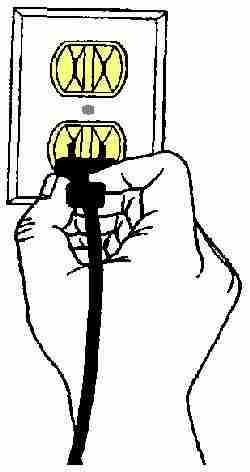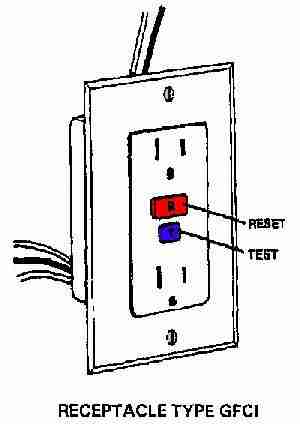Consumer Product Safety Commission
GFCIs Fact Sheet
CPSC Document #99
THE GFCI
A "GFCI" is a ground fault circuit interrupter. A
ground fault circuit interrupter is an inexpensive electrical
device that, if installed in household branch circuits, could
prevent over two-thirds of the approximately 300 electrocutions
still occurring each year in and around the home. Installation of
the device could also prevent thousands of burn and electric
shock injuries each year.
The GFCI is designed to protect people from severe or fatal
electric shocks Because a GFCI detects ground faults, it can also
prevent some electrical fires and reduce the severity of others
by interrupting the flow of electric current.

THE PROBLEM
Have you ever experienced an electric shock? If you did, the
shock probably happened because your hand or some other part of
your body contacted a source of electrical current and your body
provided a path for the electrical current to go to the ground,
so that you received a shock.
An unintentional electric path between a source of current and a
grounded surface is referred to as a "ground-fault."
Ground faults ground-fault. Ground faults occur when current is
leaking somewhere, in effect, electricity is escaping to the
ground. How it leaks is very important. If your body provides a
path to the ground for this leakage, you could be injured,
burned, severely shocked, or electrocuted.
Some examples of accidents that underscore this hazard include
the following:
- Two children, ages five and six, were electrocuted in Texas
when a plugged-in hair dryer fell into the tub in which they were
bathing.
- A three-year-old Kansas girl was electrocuted when she touched
a faulty countertop.
These two electrocutions occurred because the electrical current
escaping from the appliance traveled through the victim to ground
(in these cases, the grounded plumbing fixtures). Had a GFCI been
installed, these deaths would probably have been prevented
because a GFCI would have sensed the current flowing to ground
and would have switched off the power before the electrocution
occurred.
HOW THE GFCI WORKS
In the home's wiring system, the GFCI constantly monitors
electricity flowing in a circuit, to sense any loss of current.
If the current flowing through the circuit differs by a small
amount from that returning, the GFCI quickly switches off power
to that circuit. The GFCI interrupts power faster than a blink of
an eye to prevent a lethal dose of electricity. You may receive a
painful shock, but you should not be electrocuted or receive a
serious shock injury.
Here's how it may work in your house.. Suppose a bare wire
inside an appliance touches the metal case. The case is then
charged with electricity. If you touch the appliance with one
hand while the other hand is touching a grounded metal object,
like a water faucet, you will receive a shock. If the appliance
is plugged into an outlet protected by a GFCI, the power will be
shut off before a fatal shock would occur.
AVAILABILITY OF GFCIs
Three common types of ground fault circuit interrupters are
available for home use:
* RECEPTACLE TYPE
This type of GFCI is used in place of the standard duplex
receptacle found throughout the house It fits into the standard
outlet box and protects you against "ground faults' whenever
an electrical product is plugged into the outlet Most
receptacle-type GFCIs can be installed so that they also protect
other electrical outlets further "down stream" in the
branch circuit.
* CIRCUIT BREAKER TYPE
In homes equipped with circuit breakers rather than fuses, a
circuit breaker GFCI may be installed in a panel box to give
protection to selected circuits The circuit breaker GFCI serves a
dual purpose - not only will it shut off electricity in the event
of a "ground-fault," but it will also trip when a short
circuit or an over-load occurs Protection covers the wiring and
each outlet, lighting fixture, heater, etc served by the branch
circuit protected by the GFCI in the panel box.
* PORTABLE TYPE
Where permanent GFCIs are not practical, portable GFCIs may be
used One type contains the GFCI circuitry in a plastic enclosure
with plug blades in the back and receptacle slots in the f rant.
It can be plugged into a receptacle, then, the electrical product
is plugged into the GFCI. Another type of portable GFCI is an
extension cord combined with a GFCI. It adds flexibility in using
receptacles that are not protected by GFCIs.

WHERE GFCIs SHOULD BE CONSIDERED
In homes built to comply with the National Electrical Code
(the Code), GFCI protection is required for most outdoor
receptacles (since 1973), bathroom receptacle circuits (since
1975), garage wall outlets (since 1978), kitchen receptacles
(since 1987), and all receptacles in crawl spaces and unfinished
basements (since 1990).
Owners of homes that do not have GFCIs installed in all those
critical areas specified in the latest version of the Code should
consider having them installed. For broad protection, GFCI
circuit breakers may be added in many panels of older homes to
replace ordinary circuit breaker. For homes protected by fuses,
you are limited to receptacle or portable-type GFCIs and these
may be installed in areas of greatest exposure, such as the
bathroom, kitchen, basement, garage, and outdoor circuits.
A GFCI should be used whenever operating electrically powered
garden equipment (mower, hedge trimmer, edger, etc.). Consumers
can obtain similar protection by using GFCIs with electric tools
(drills, saws, sanders, etc.) for do-it-yourself work in and
around the house.
INSTALLING GFCIs
Circuit breaker and receptacle-type GFCIs may
be installed in your home by a qualified electrician.
Receptacle-type GFCIs may be installed by knowledgeable consumers
familiar with electrical wiring practices who also follow the
instructions accompanying the device. When in doubt about the
proper procedure, contact a qualified electrician. Do not attempt
to install it yourself.
The portable GFCI requires no special knowledge or equipment to
install.
TESTING THE GFCIs
 All GFCIs should be tested once a month to make
sure they are working properly and are protecting you from fatal
shock. GFCIs should be tested after installation to make sure
they are working properly and protecting the circuit. All GFCIs should be tested once a month to make
sure they are working properly and are protecting you from fatal
shock. GFCIs should be tested after installation to make sure
they are working properly and protecting the circuit.
To test the receptacle GFCI, first plug a nightlight or lamp into
the outlet. The light should be on Then, press the
"TEST" button on the GFCI. The GFCI's "RESET"
button should pop out, and the light should go out.
If the "RESET" button pops out but the light does not
go out, the GFCI has been improperly wired. Contact an
electrician to correct the wiring errors.
If the "RESET" button does not pop out, the GFC1 is
defective and should be replaced.
If the GFCI is functioning properly, and the lamp goes out, press
the "RESET" button to restore power to the outlet.
009411
GPO: 1996 O-169-574
|